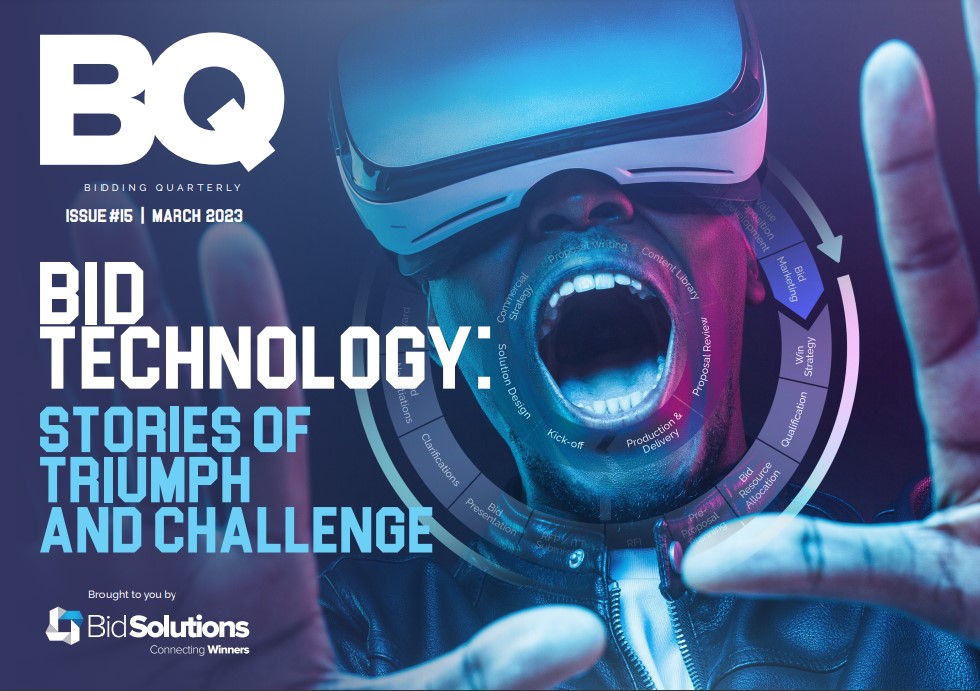
Why is it that technology causes such a stir when we talk about it entering a new era or profession? What makes it unsettling, threatening or unnerving? One of the challenging things about writing an article on tech is the sheer pace it moves at. If we are to pause a moment and look at where we’ve come from – the inception point being a bouncing paperclip in a Word document (we miss you, Clippy), to a large language model that can draft answer plans for you (such as the much hyped chatbot, ChatGPT), you will see we still have a long journey to embark on – and you’re better off getting on-board now, before you find yourself without a competitive edge.
Why are we suddenly interested in AI?
When we talk about tech in bidding, the elephant in the room is the dawn of artificial intelligence (AI). AI has been growing in popularity and usage over the last few years and we have seen a number of systems developed, including programs that can generate images, text, presentations and avatars. ChatGPT is the first program that has really resonated with the masses, and this is largely down to a marketing ploy by the developers – it was developed from human feedback to generate outputs that appeared to be, well, human. What makes this time interesting is how models are being trained. Previously, models were trained to be very specific, performing actions like recognising handwritten numbers – this is what algorithms such as spam filters look at. The recent wave of innovation can identify and fine tune a wide range of data, enabling it to tackle more specific problems. This opens the opportunity for bespoke models to be used for proposals.
For AI to enter the workplace and sit beside you as the co-worker you have always wanted, it has to be meaningful and add value.
What can we do now?
Using some of the existing AI tools can help teams do more, faster. Below, I explore some of the shortcuts you can use but it is important to remember these tools haven’t been specifically developed for bidding, so elements like strategy and decision making should be left to the professionals.
| Platform | Function | Command |
| ChatGPT v.3.5
| Simplify language | [insert text/paragraph] simplify this text |
| List acronyms | [insert text/paragraph] list and define acronyms in this text | |
| Create bios | [insert CV text and define style/ word limit] create biography/overview | |
| Draft answer plan | Create me a [performance management plan] | |
| Review compliance | [insert text] pull out requirements | |
| Stable Diffusion / DALL-E / Midjourney | Generate a new image | Create an image of [a bridge being constructed] |
| Tome | Generate slide deck including graphics and content | Create me a slide deck on [HS2 phase 2a] |
| Jasper | Generate written content | Write me a short answer on [integrating carbon management] |
This list is by no means exhaustive, but it demonstrates that by trialling different commands, you can bypass some of the initial and often messy idea generation phases in the bid process. In a nutshell, AI currently harnesses the ability to access an abundance of data and provide you with the best and most appropriate data set. What you do with this data is where the real value lies.
What’s the catch?
Going back to the original question, where does our hesitation come from? There are of course limitations to AI and risks to be aware of, as with any cloud-based system (or new colleague). Some risks include:
- Data sensitivity – inputting sensitive data into cloud-based systems may pose a security risk. Therefore it is important to consult a cyber security professional if you intend on inputting sensitive data.
- Referencing – not all programs will provide you with references, so if you’re using a large language model for research, you will be better off using a program like Perplexity, which will link you to the various sites it has drawn from.
- Data accuracy – it is true the response you get back may not be correct, as the data is only as good as the person who inputted it. Don’t rely on AI to be right first (or even second) time.
- Net new answers – AI can only pull from what it knows. If there is something truly innovative and ground-breaking, this will need human expertise to generate.
What does it mean for the future?
If we are to assume we will adopt AI as a part of our every day, and use it to its full potential, what does that mean for the medium term?
It’s not as sci-fi fantasy as you might think. The primary use for AI will remove the need for human CRUD (create, read, update, delete) data management, such as bid libraries, bid programming and comment control. It will aid in creating a compliant response and analysing documents quickly, which will ultimately allow for more time to be spent on strategy, positioning, and refining. It has the ability to level the playing field across competitors, which will put more focus on human factors, and potentially see a new wave of behavioural analysis emphasis and focus on individual capability and experience. After all, an AI tool will struggle to adapt a process based on situation – the bid manager’s superpower.
AI will continue to be plugged in to everyday systems, such as Microsoft, and you will begin to see recommended text based on your individual algorithms.
Ultimately, technology is there to support us, and give back time – harnessed correctly, tools will support in more collaborative, intuitive and intelligent bidding. As Matt Mullenweg so neatly put it, “Technology is best when it brings people together.”
This article was written by Samantha Burns.
Sam Burns CP APMP is a Senior Bid Manager at EiB. Sam has over 11 years’ experience and has worked in both the private and public sector, helping clients win transformational projects across the UK and globally. She has a passion for technology and pioneering solutions in the full business development lifecycle.

